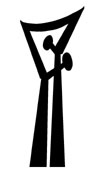
Bryn Mawr College

 |
Center Bryn Mawr College | 
|
January 30, 2003
Al Albano, Sharon Burgmayer, Peggy Hollyday
Diamond-Cutters, Net-Casters and Day-Dreamers: Differences among Scientists
Sharon, Peggy and Al asked us to prepare for this discussion by reading two short pieces: a letter about the high school sequence of science courses, published in the November 11, 2002 edition of Chemical and Engineering News, and a short summary prepared by Al about "Differences among Physicists." They began their joint presentation with the statement (and a figure to illustrate) that among the natural sciences, there is an inverse relationship between the complexity of the system being studied and the mathematical sophistication of the tools used to study it. Biology or geology, which look at very complex systems, rely less on mathematics than, for instance, elementary particle physics. The cross-over, at least according to chemists, is physical chemistry, which studies relatively complex systems using relatively complex mathematics. There was some discussion about whether earth science (for instance) is taught without math because it is offered so early in high school, or whether chemistry and physics are so math-dependent because of the "historical accident" that math played an important role in the development of ideas in those fields (which need not be taught as they were developed). A range of ancedotes were shared about experiences in high school science courses; the new "physics first" initiative and its underlying "reductionist agenda" was also discussed. The impossibility of running an experiment in earth science was mentioned (one is, rather, watching the past). Discussion then turned to the question of whether the choice to engage in a particular discipline is the result of what an individual cares about, or whether indoctrination matters. Is there an inherent linear progression in the way the science sequence is taught, from building blocks to larger complex issues, in the form of an emergent system?
We next discussed the styles and approaches among scientists, not just in different fields, but within the same one. Sharon, Peggy and Al described "diamond cutters" as those driven by well-established theoretical structures, who aim at great experimental precision or theoretical rigor. "Net casters," in contrast, study phenomena whose properties are not understood or not firmly situated in established theoretical structures; they seek patterns which may eventually help reach that understanding. "Day dreamers" seek explanations of natural phenomena in terms of theoretical constructs possessing great simplicity and elegance. Peggy, a self-described "net caster," showed representations of her work as fishing expedition, in which she monitors chick embryos, asking why different parts of the brain become different. Sharon, who described her work as a cross between "net casting" and "day dreaming," shared slides illustrating the tangible work done building molecules in her lab; she then contrasted those images with the different abstract figures with which they could be illustrated: her own schematic models of reactions, which differed strikingly from the spectra seen by her Keck Fellow, Samantha Glazier. Al, the "diamond cutter" of the group, described his mathematical computations of the data generated by Peter Brodfuehrer's experiments with stimulating leeches.
It was suggested that this range of descriptors could also be applied, in the form of a cyclic evolution, to each scientist, lab, field and publication: from "dreaming" up the project, to "netcasting" for data, to "diamond cutting" it to a fine precision to see how well it all fits. The three categories were also mapped onto Thomas Kuhn's description of the three forms of "normal science":
We ended with questions about what trajectory is most useful in training students. Should we start by teaching them the tools they will need; should they spend years learning the necessary techniques? Or should we ask them first to come up with their own experiments, and then backfill to supply the tools they need to run them? This is of course the challenge of education: recognizing the different styles of different students, and making it okay for them to break out of the mold. There are multiple ways to get to the same end.
Ending our conversation at this point provided a good transition into next week's topic, "The Effects of the Culture of Science on Students," as seen from the perspective of the Dean of the College, Karen Tidmarsh.
Home
| Calendar | About
| Getting Involved
| Groups | Initiatives | Bryn Mawr Home | Serendip Home
Director: Liz McCormack -
emccorma@brynmawr.edu
| Faculty Steering Committee
| Secretary: Lisa Kolonay
© 1994-
, by Center for Science in Society, Bryn Mawr College and Serendip
Last Modified:
Wednesday, 02-May-2018 11:57:05 CDT